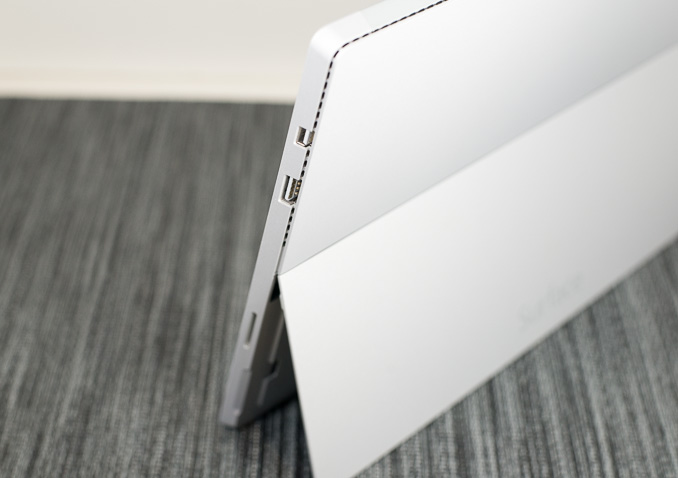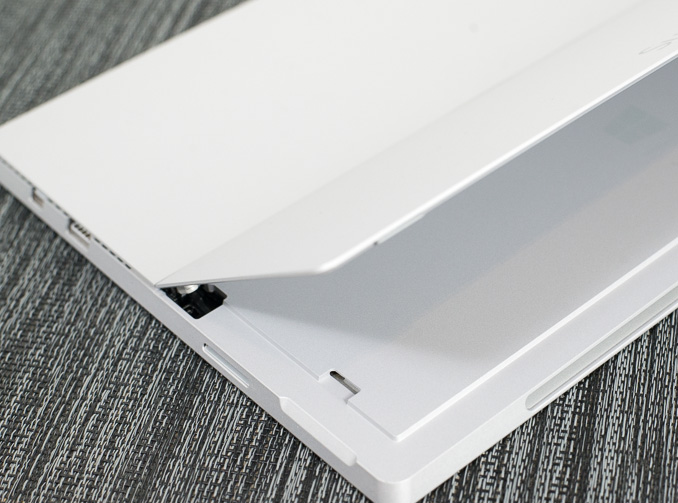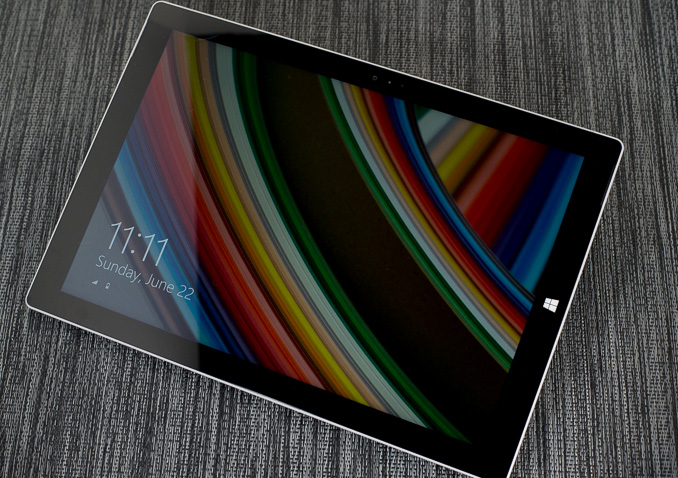Microsoft Surface Pro 3 Review
by Anand Lal Shimpi on June 23, 2014 3:55 AM ESTFinal Words
When I reviewed the first Surface Pro I was intrigued by the idea, but felt it needed a few more iterations to get to the right point. In less than two years what we have in front of us looks very different than Microsoft's original vision for the platform. Display size, aspect ratio and even the mechanics of the whole thing are all quite different. The changes are for the better as Surface Pro 3 is a much better laptop and a much better tablet than any of its predecessors. The device no longer feels cramped and tiring to use as a laptop. The new Surface Pro no longer feels heavy to use as a tablet either. It's truly an improvement on both vectors.
Microsoft might be overselling the design to say that it truly is the only device you need. Like most compromises, Surface Pro 3 isn't the world's best laptop nor is it the world's best tablet. It serves a user who wants a little of column A and a little of column B.
The device's "lapability" is tremendously better than any of its predecessors. While I wrote all of the previous Surface reviews on the very Surface devices I was reviewing, this is by far the most comfortable one to use as a laptop. It's still not perfect, and you still need a fairly long lap to make it work, but the design is finally really usable as a laptop.
As a tablet the thinner and lighter chassis is much appreciated. The new kickstand remains one of the best parts of the design, enabling a flexibility unmatched by any other tablet. Tent mode in particular is awesome for tablet usage models.
Surprisingly enough the move away from Wacom to an active NTrig pen model comes with very few issues. The device could use some tuning of its pen pressure curves. Applying max pressure on the screen now distorts the LCD, something I'm never comfortable doing. But overall the new pen gives up very little and even improves performance and functionality.
The new Type Cover is awesome. The keyboard is probably as good as it's going to get, and the new trackpad is finally usable. The latter isn't perfect but it's so much better than anything that's come before it.
The device also launches with a far more polished version of Windows. With its latest updates, Windows 8.1 is a far cry from where it first started. I still think there's lots of room for improvement, but it's clear that Microsoft is marching towards a more cohesive vision of modern and desktop Windows UIs.
The downsides for Surface Pro 3 are obvious. Windows 8.1 remains a better desktop/notebook OS than a tablet OS. Yet in a device like Surface Pro 3 where you're forced to rely on touch more thanks to a cramped trackpad, I'm often in a situation where I'm interacting with the Windows desktop using the touchscreen - a situation that rarely ends well. As Microsoft improves the behavior of its modern UI apps, I would love to see a rethinking of what touch looks like on the desktop. If Surface Pro 3 exists to blur the lines between laptop and tablet, Windows 9 needs to do a better job of the same. The desktop needs to react better to touch and the modern apps need to feel even more integrated into the desktop.
On the hardware side, the device is a compromise. You have to be willing to give up some "lapability" in order to get a unified laptop/tablet device. Whether what you get as a tablet is worth the tradeoff is going to be up to how good of a tablet OS Windows 8.1 is for you. Personally I find that Android and iOS deliver better tablet experiences particularly when it comes to 3rd party applications. If everything you need on the tablet front is available in the Windows Store however then the point is moot.
Those users upgrading from Surface Pro 2 may notice a regression in performance, particularly when it comes to running prolonged CPU/GPU intensive workloads. In games, the difference can be noticeable. The simple fact is that in becoming a thinner device, Surface Pro 3 inherited more thermal constraints than its predecessors. While performance regressions aren't ideal, in this case I can appreciate what Microsoft has done. From the very beginning I wanted a lower TDP part in a thinner chassis. Had Microsoft done that from the start we wouldn't have seen any performance regression but rather a steady increase over time. From my perspective, Surface Pro 3 is simply arriving at the right balance of thermals and performance - the previous designs aimed too high on the performance curve and required an unreasonably large chassis as a result.
The remaining nitpicks are the same as last time: Microsoft needs to embrace Thunderbolt, and a Type Cover should come with the device. The display's color accuracy is good but grayscale performance needs some work.
Surface Pro 3 is easily the best design Microsoft has put forward. If you were intrigued by the previous designs, this is the first one that should really tempt you over. I was a fan of the original Surface Pro, and with Surface Pro 3 I think Microsoft has taken the hardware much closer to perfection. At this point the design needs more help on the software side than hardware, which is saying a lot for the Surface Pro hardware team. Personally I'd still rather carry a good notebook and a lightweight tablet, but if you are looking for a single device this is literally the only thing on the market that's worth considering. I don't know how big the professional productivity tablet market is, but it's a space that Microsoft seems to have almost exclusive reign over with its Surface line. With its latest iteration, Microsoft is serving that market better than ever.













274 Comments
View All Comments
mkozakewich - Monday, June 30, 2014 - link
In that case, you should probably just connect it to a 4K monitor.jjstreic - Tuesday, June 24, 2014 - link
PCIe = Direct Memory Access = Disk encryption security hole (look for firewire exploits). The lack of PCIe is a _good_ thing for security. Also, my reading indicates PCIe is an optional component of Thunderbolt, not mandatory.iceman-sven - Tuesday, June 24, 2014 - link
???One has nothing to do with the other. From http://www.nvmexpress.org:
The NVM Express specification, developed cooperatively by more than 80 companies from across the industry, was released on March 1, 2011, by the NVMHCI Work Group (commonly referred to as the NVM Express Work Group). The NVM Express 1.0 specification defines an optimized register interface, command set and feature set for PCI Express® (PCIe®) Solid-State Drives (SSDs). The NVM Express 1.1 specification was released on October 11, 2012 adding additional Enterprise and Client capabilities. The goal is to deliver the full performance capabilities of current and next generation non-volatile memory, supporting at least a 10 year life of the interface, while standardizing the PCIe SSD interface to enable broad ecosystem support.
The significant advances in performance enabled by non-volatile memory-based storage technology, as embodied in PCIe-based SSDs, has demanded the surrounding platform infrastructure evolve to keep pace, to realize the full potential of these devices. A primary goal of NVM Express is to provide a scalable interface that unlocks the potential of PCIe-based SSDs now and at least a decade into the future. The interface efficiently supports multi-core architectures, ensuring thread(s) may run on each core with their own SSD queue and interrupt without any locks required. For Enterprise class solutions, there is support for end-to-end data protection, security and encryption capabilities, as well as robust error reporting and management capabilities.
There is nothing hindering encryption on a PCIe SSD. And Thunderpolt without PCIe is pure DisplayPort. It makes no sense. And I am sure, DMA is optional and can be blocked per device.
humsinger - Monday, June 23, 2014 - link
This just might be the best review I have ever read. I am usually just a google-what-i-am-looking-for-and-read-the-first-couple-results kind of guy. But after reading this masterpiece I will be on the lookout for anandtech in the future! Thanks for the hard work and keep it coming.nos024 - Monday, June 23, 2014 - link
Not including the keyboard is a deal breaker for me. I'd probably get a Yoga 2 pro over this.nerd1 - Monday, June 23, 2014 - link
Yoga 2 pro is almost the same price, 2X heavier and has 16:9 screen...Carmien - Monday, June 23, 2014 - link
My first impressions - of actually using a Surface Pro 3 - after a few days are really, REALLY good. I'm using the i5 Surface Pro 3 (8 GB RAM) and I've got to tell you it is an amazing piece of hardware. My other laptop is a fully loaded Vaio Z3 that cost twice as much two years ago.As for software, I'm running applications like Office, Novamind, Minitab 16. The design is great. I have no significant issues with heat. I've been enjoying extended Netflix sessions. First, the tablet has gotten "warm" but there are no heat issues. I even went so far as to place it on my bare legs after several hours and there was no discomfort. As an aside, this is the first mobile device where I didn't feel the need to use external speakers. And whatever they're doing with the Dolby codex is working. For two speakers I was very nicely surprised by the sound field for such a small device. It's far from a high end sound system, but it is heads above anything compatible.
As for processing power this is more than capable. I have also been running a workflow designer (browser based), as well as Office apps, and this takes anything I've thrown at it. Reports of wake up issues on sleep or rebooting don't seem to be present for me. MSFT did promise a fix that appears to have made it into release systems. The wake up speed on sleep is instant. Boot up and shut down speeds are much faster than my already capable Z3 (256GB SSD and 8GB RAM with an older i7 CPU).
The keyboard is more than capable. I switch between a Vaio Z3 and the Surface Pro 3 effortlessly. The trackpad isn't as good as the Vaio but the thing is, once you start getting used to the stylus and touchscreen the trackpad really is moot. The only reason I would use the trackpad is because I've forgotten to use the screen or stylus. In other words, the weaknesses on this system get gobbled up by its strengths and then some. If you're capable of changing habits you'll do just fine. After all, touchscreen really is more efficient than a mouse or trackpad - so the return for that change is more than worthwhile.
My favourite feature - the stylus. Taking notes in OneNote is really well done. I can draw process maps and take meeting notes so effortlessly. MSFT finally created an integrated writing solution - and yes, they added a Pen Addin for Office apps as well. Anyone who facilitates meetings and scribes notes for later reference will love this. The weight is amazing - even with the type cover I can carry this around with me comfortably. As a side note, the screensize ratio really is worth it - which reminds me of how good my Netflix viewing experience was last night.
I've used an iPad in the past for a while before setting it down for its lack of functionality, and obviously, the Surface Pro 3 shows it a thing or twenty. Next to a powerful laptop it more than holds its own. The iPad was fun as a tablet, but the Surface Pro 3 is both fun AND functional - It is FUNctional. I do agree with comments about how close MSFT has gotten to getting the hybrid approach right.
I'll see how this handles over time. I've deliberately made a switch in parallel with my other laptop. I can't afford to go without a working computer from a business perspective. But I'm starting to think I could take this as a replacement system on the road. As more applications (that I use) come online designed for Metro the more relevant this tablet/laptop will become.
All in all, this is the most fun I have ever had with a new mobile device. I can see why those locked into the Apple ecosystem will hesitate. But if you are on the fence, or a Windows user, you will really enjoy this. And yes, the cool factor is immense. Who would have imagined that MSFT would design a device that looks just as cool as an iThingy...
Razzy76 - Tuesday, June 24, 2014 - link
I thought the trackpad is very good on SP3, make sure your setting is right. I had to tick Enhance pointer precision and the pointer speed in middle to make the trackpad very responsive.Wolfpup - Monday, June 23, 2014 - link
It might be nice if the i3 model was fanless. The 12" screen (+ real windows) Seems awesome for reading graphic novels and magazines, BUT I'm not sure how I'd feel about a fan going off while I'm reading...Very, very interesting tablet though that I'm toying with getting...
kyuu - Monday, June 23, 2014 - link
The fan will be either off or inaudible during light workloads like reading, especially with the i3 that is a lower TDP than the i5 model in this review. I wouldn't let the worry of fan noise get in the way.